中考英语二轮专题复习 句子成分讲解 课件(共37张PPT)
文档属性
| 名称 | 中考英语二轮专题复习 句子成分讲解 课件(共37张PPT) | 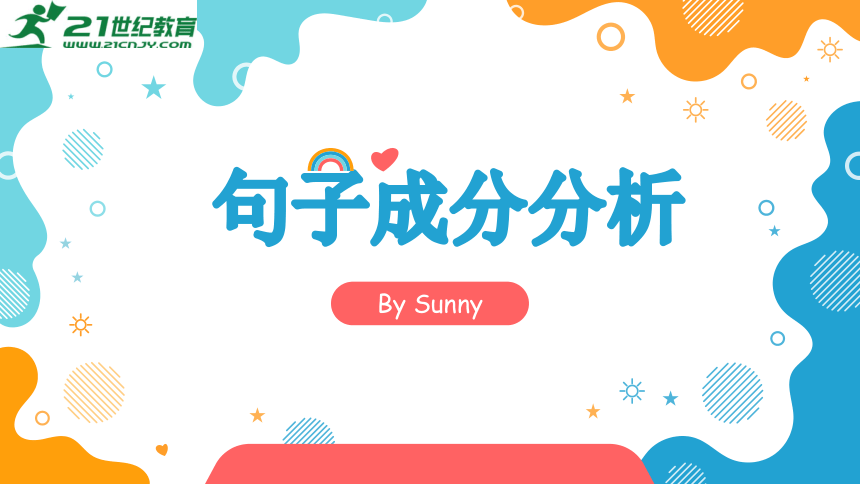 | |
| 格式 | pptx | ||
| 文件大小 | 32.9MB | ||
| 资源类型 | 试卷 | ||
| 版本资源 | 通用版 | ||
| 科目 | 英语 | ||
| 更新时间 | 2022-12-08 18:48:17 | ||
图片预览

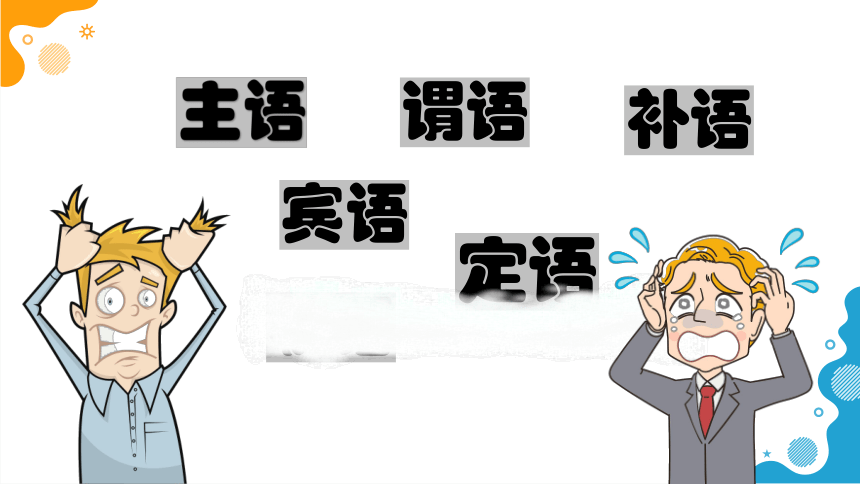
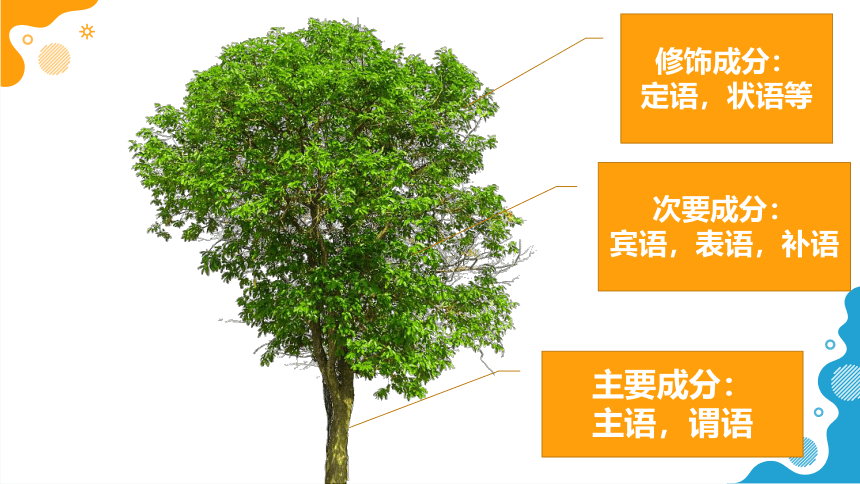
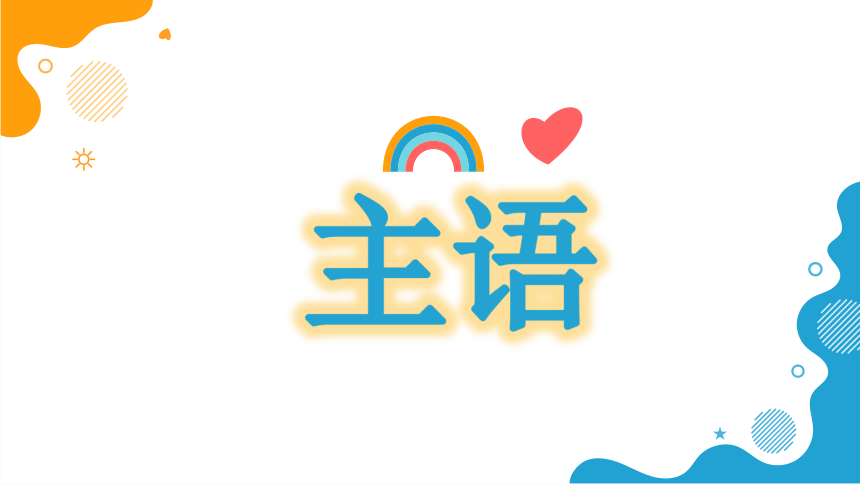
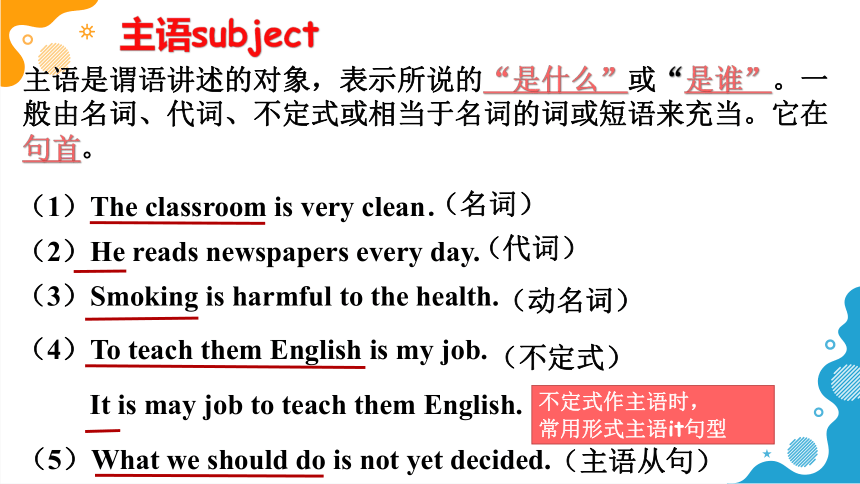
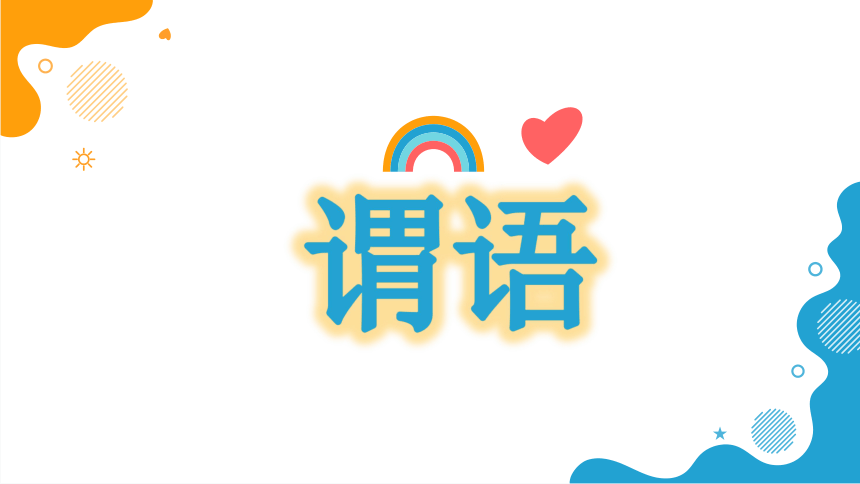

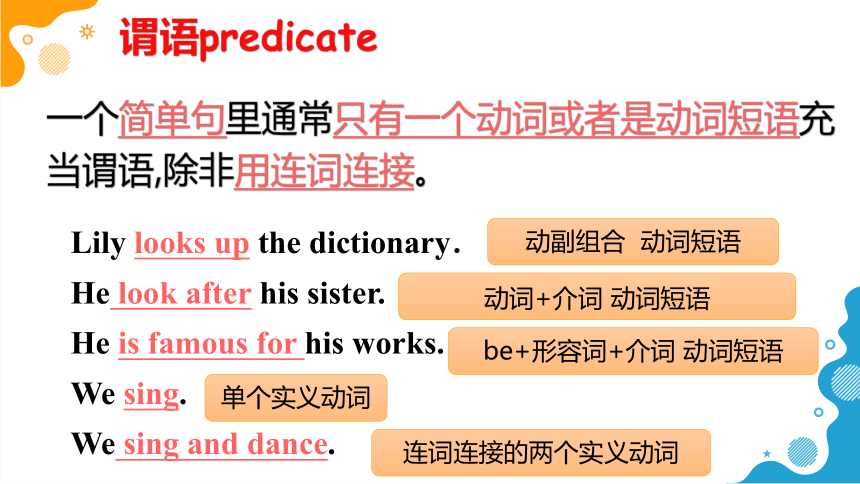
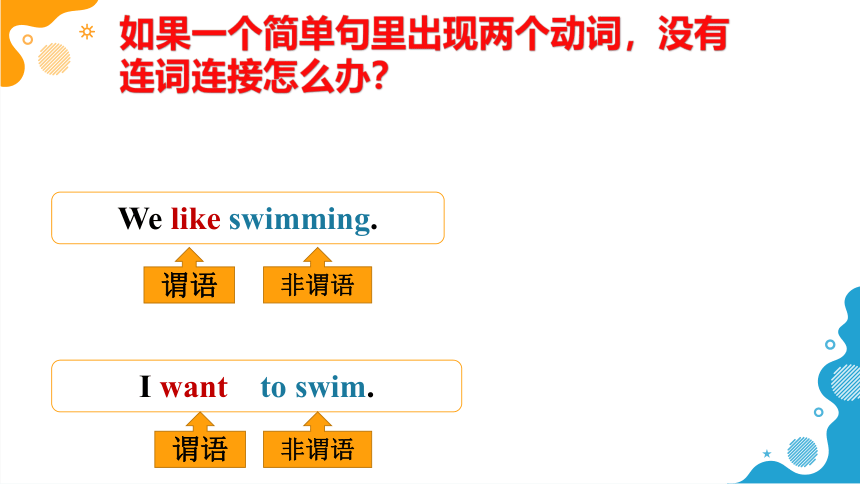
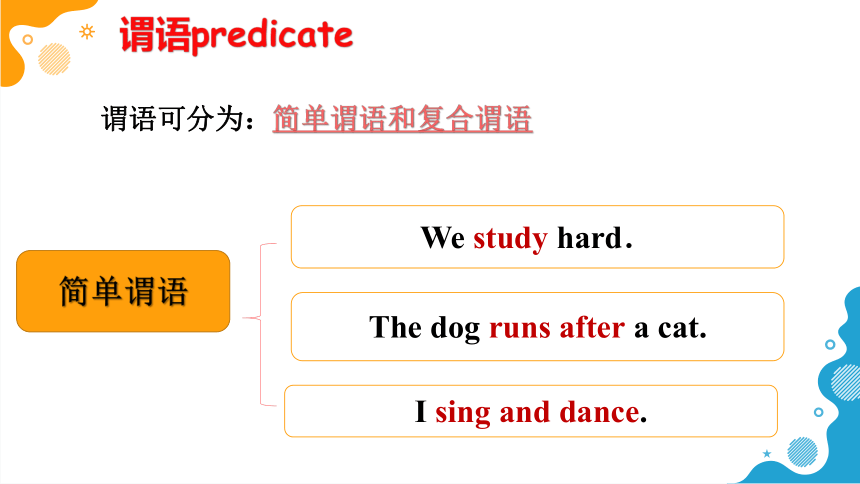
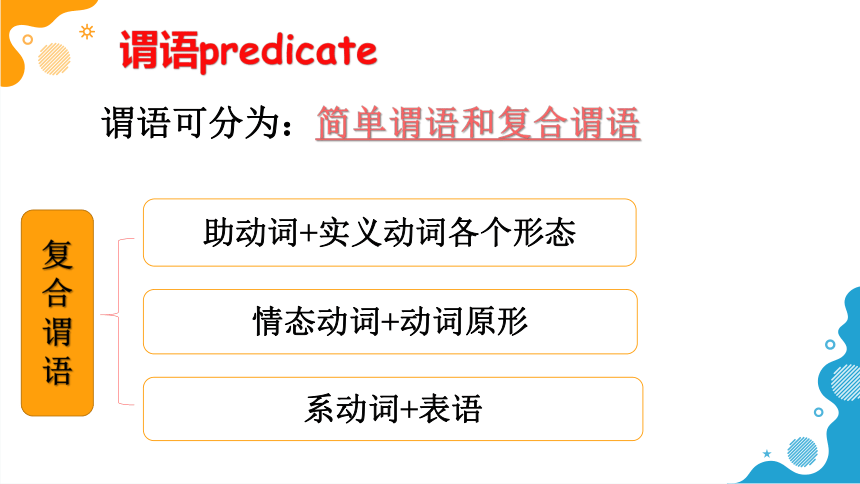
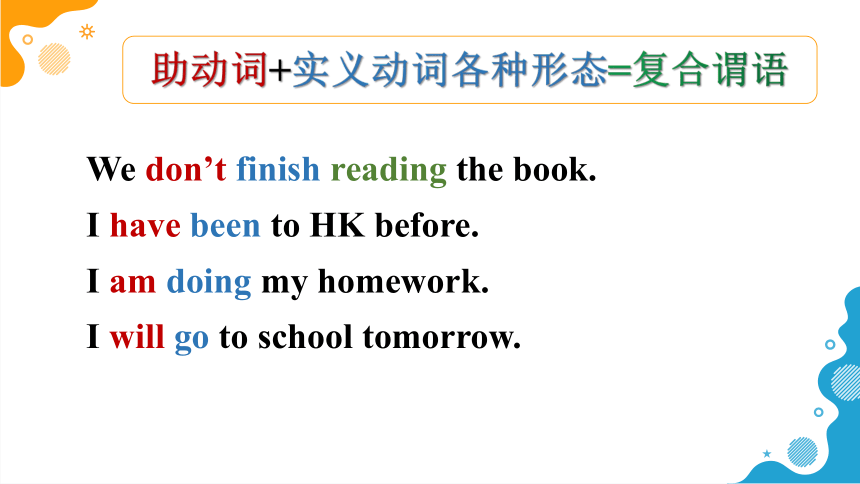
文档简介
(共37张PPT)
句子成分分析
~ 稻小壳演示 ~
By Sunny
主语
宾语
谓语
定语
状语
补语
__________
主要成分:
主语,谓语
次要成分:
宾语,表语,补语
修饰成分:
定语,状语等
主语
主语subject
主语是谓语讲述的对象,表示所说的“是什么”或“是谁”。一般由名词、代词、不定式或相当于名词的词或短语来充当。它在句首。
(1)The classroom is very clean.
(2)He reads newspapers every day.
(3)Smoking is harmful to the health.
(4)To teach them English is my job.
It is may job to teach them English.
(5)What we should do is not yet decided.
不定式作主语时,
常用形式主语it句型
(名词)
(代词)
(动名词)
(不定式)
(主语从句)
谓语
谓语predicate
说明主语“做什么”、“是什么”或“怎么样”,谓语(谓语部分里主要的词)必须用动词。谓语和主语在人称和数两方面必须一致,它在主语后面。
谓语predicate
一个简单句里通常只有一个动词或者是动词短语充当谓语,除非用连词连接。
Lily looks up the dictionary.
He look after his sister.
He is famous for his works.
We sing.
We sing and dance.
动副组合 动词短语
动词+介词 动词短语
be+形容词+介词 动词短语
单个实义动词
连词连接的两个实义动词
如果一个简单句里出现两个动词,没有连词连接怎么办?
We like swimming.
I want to swim.
非谓语
谓语
谓语
非谓语
谓语predicate
谓语可分为:简单谓语和复合谓语
简单谓语
We study hard.
The dog runs after a cat.
I sing and dance.
谓语predicate
谓语可分为:简单谓语和复合谓语
复
合
谓
语
助动词+实义动词各个形态
情态动词+动词原形
系动词+表语
助动词+实义动词各种形态=复合谓语
We don’t finish reading the book.
I have been to HK before.
I am doing my homework.
I will go to school tomorrow.
系动词+表语=复合谓语
His parents are teachers.
Four and four is eight.
It sounds interesting.
I feel cold.
We keep heathy.
She is in red.
宾语
宾语object
宾语是动作、行为的对象,由名词、代词、不定式或相当于名词的词、短语来担任,它和及物动词一起说明主语做什么,在谓语之后。
(1)She is playing the piano now.
(2)She says(that)she is ill.
(3)He often helps me.
(4)He likes to play basketball.
(5)We enjoy listening to the music.
(名词作宾语)
(宾语从句作动词宾语)
(代词作宾语)
(不定式作宾语)
(动名词短语作宾语)
★宾语分直接宾语和间接宾语。(双宾)
间接宾语指人,直接宾语指物
可跟双宾的动词举例:
give sb. sth. 给某人某物 show sb. sth. 给某人看某物 bring sb. sth. 给某人带来某物 pass sb. sth. 递给某人某物 buy sb. sth.
给某人买某物
①Your mother bought you a book. (buy-bought) ②The sun gives us light. 宾语补足语object complement
补充说明宾语的动作、状态、特征的成分。名词、形容词、副词、介词短语以及动词不定式、分词等可用作宾语补足语。 “宾语+宾语补足语” =复合宾语
(1)They make her happy.
(2)I want you to help me.
(3) Please let him out.
(4)The boss kept them working all day.
(5)Yesterday he got his leg broken.
(6)Make yourself at home.
(形容词)
(不定式)
(副词)
(现在分词)
(过去分词)
(介词短语)
双宾语结构可进行“to”和”for”的替换。
举例:give sb. sth.=give sth. to sb.
buy sb. sth.=buy sth. for sb.
可以变成to结构 give, show, send, bring, read, pass, lend,tell, return, write, promise(答应), refuse(拒绝),teach
可以变成for 结构 make(制作), buy
中考常考:
表语
表语predicative
表语说明主语“是什么”或者“怎么样”,由名词、形容词、副词、介词短语、不定式及相当于名词或形容词的词或短语来担任。它的位置在系动词后面。
要了解表语,只要记住系动词,系动词后面就是表语。
系动词 Linking verb.
中考主要系动词
Be动词:am,is,are, was, were
感官动词:
feel(感觉起来),sound(听起来),taste(尝起来),smell(闻起来)seem/look(看起来),
表改变:get, become, turn
表保持:keep, stay, remain
系动词+表语=复合谓语
(1)I am a teacher.
(2)He is always happy.
(3)They are on the playground now.
(4)It gets cold.
初高中常考:形容词做表语。
(名词)
(形容词)
(介词短语)
(形容词)
定语
定语attributive
定语用来修饰名词或代词,凡是有名词、代词的地方都可以有定语形容词、代词、数词、名词、介词短语,不定式或相当于形容词的词或短语等都可以担任定语。
I have something to do.
I tell him something interesting.
一、修饰代词
(不定式作定语)
(形容词做定语)
定语attributive
二、修饰名词
a girl
a lovely girl
a five-year-old girl
a girl in a hat
a girl who wears a dress
定语attributive
二、修饰名词
girl
a
lovely
five-year-old
in a hat
who wears a dress
名词
词
短语、句子
前置定语
后置定语
定语attributive
The black bike is mine.
What’s your name
They make paper flowers.
The boys in the room are in Class Three Grade One.
I have something to do.
Harry Porter is a boy who has magic power.
(形容词)
(代词)
(名词)
(介词短语语)
(不定式)
(定语从句)
找出句子中的定语:
I have an intersting new English book.
总结:一个句子里面,定语可以有多个。
状语
状语adverbial
修饰动词、形容词、副词。(时间、地点、目的、方式、程度等),一般由副词、介词短语、不定式或相当于副词的词或短语来表示。
(1) He did it carefully.
(2) We often help him.
(3) Her mother goes out to do some shopping on Sunday.
(4) When I grow up, I am going to be a teacher.
(5) He sits there.
(副词)
(介词短语)
(频率副词)
(从句)
(地点副词)
状语的位置
例:
(1) The little girl cried loudly. (动词后面)
(2)Unluckily, we failed the football match at last. (句首)
一、1.评论性的副词用于句首或者修饰动词短语放于其后,均为状语(表状态或程度)
状语的位置
例:我每天下午和朋友一起在学校打篮球是为了耍帅。
I play basketball with my friends at school every afternoon
in order to show off.
二.一般状语的顺序可以调整。
方式
地点
时间
目的
状语的位置
(Last week,) I went to Beijing (last week).
(To catch the early bus,) I got up at four yesterday (to catch the early bus.)
时间、目的状语可位于句首(一般用“,”和主句隔开),也可直接放于句尾。
注意:时间和地点状语,先小后大。
同位语
同位语 Appositive
(1) Their friend, Danny Lin, was waiting at the airport.
(2)Mr.Smith, our new teacher, is very kind to us.
当两个指同一事物的句子成分放在同等的位置时,一个成分可被用来说明或解释另一个成分,前者叫做后者的同位语。
I saw my friend , Lily, running in the park
yesterday and she was very happy.
一个句子分析句子成分。
主语
谓语
定语
宾语
同位语
补语
地点状语
时间状语
主语
系动词
状语
表语
连词,虚词,不做成分
SCHOOL FOR CHILDREN
好好学习一起共同进步
THANKS
句子成分分析
~ 稻小壳演示 ~
By Sunny
主语
宾语
谓语
定语
状语
补语
__________
主要成分:
主语,谓语
次要成分:
宾语,表语,补语
修饰成分:
定语,状语等
主语
主语subject
主语是谓语讲述的对象,表示所说的“是什么”或“是谁”。一般由名词、代词、不定式或相当于名词的词或短语来充当。它在句首。
(1)The classroom is very clean.
(2)He reads newspapers every day.
(3)Smoking is harmful to the health.
(4)To teach them English is my job.
It is may job to teach them English.
(5)What we should do is not yet decided.
不定式作主语时,
常用形式主语it句型
(名词)
(代词)
(动名词)
(不定式)
(主语从句)
谓语
谓语predicate
说明主语“做什么”、“是什么”或“怎么样”,谓语(谓语部分里主要的词)必须用动词。谓语和主语在人称和数两方面必须一致,它在主语后面。
谓语predicate
一个简单句里通常只有一个动词或者是动词短语充当谓语,除非用连词连接。
Lily looks up the dictionary.
He look after his sister.
He is famous for his works.
We sing.
We sing and dance.
动副组合 动词短语
动词+介词 动词短语
be+形容词+介词 动词短语
单个实义动词
连词连接的两个实义动词
如果一个简单句里出现两个动词,没有连词连接怎么办?
We like swimming.
I want to swim.
非谓语
谓语
谓语
非谓语
谓语predicate
谓语可分为:简单谓语和复合谓语
简单谓语
We study hard.
The dog runs after a cat.
I sing and dance.
谓语predicate
谓语可分为:简单谓语和复合谓语
复
合
谓
语
助动词+实义动词各个形态
情态动词+动词原形
系动词+表语
助动词+实义动词各种形态=复合谓语
We don’t finish reading the book.
I have been to HK before.
I am doing my homework.
I will go to school tomorrow.
系动词+表语=复合谓语
His parents are teachers.
Four and four is eight.
It sounds interesting.
I feel cold.
We keep heathy.
She is in red.
宾语
宾语object
宾语是动作、行为的对象,由名词、代词、不定式或相当于名词的词、短语来担任,它和及物动词一起说明主语做什么,在谓语之后。
(1)She is playing the piano now.
(2)She says(that)she is ill.
(3)He often helps me.
(4)He likes to play basketball.
(5)We enjoy listening to the music.
(名词作宾语)
(宾语从句作动词宾语)
(代词作宾语)
(不定式作宾语)
(动名词短语作宾语)
★宾语分直接宾语和间接宾语。(双宾)
间接宾语指人,直接宾语指物
可跟双宾的动词举例:
give sb. sth. 给某人某物 show sb. sth. 给某人看某物 bring sb. sth. 给某人带来某物 pass sb. sth. 递给某人某物 buy sb. sth.
给某人买某物
①Your mother bought you a book. (buy-bought) ②The sun gives us light. 宾语补足语object complement
补充说明宾语的动作、状态、特征的成分。名词、形容词、副词、介词短语以及动词不定式、分词等可用作宾语补足语。 “宾语+宾语补足语” =复合宾语
(1)They make her happy.
(2)I want you to help me.
(3) Please let him out.
(4)The boss kept them working all day.
(5)Yesterday he got his leg broken.
(6)Make yourself at home.
(形容词)
(不定式)
(副词)
(现在分词)
(过去分词)
(介词短语)
双宾语结构可进行“to”和”for”的替换。
举例:give sb. sth.=give sth. to sb.
buy sb. sth.=buy sth. for sb.
可以变成to结构 give, show, send, bring, read, pass, lend,tell, return, write, promise(答应), refuse(拒绝),teach
可以变成for 结构 make(制作), buy
中考常考:
表语
表语predicative
表语说明主语“是什么”或者“怎么样”,由名词、形容词、副词、介词短语、不定式及相当于名词或形容词的词或短语来担任。它的位置在系动词后面。
要了解表语,只要记住系动词,系动词后面就是表语。
系动词 Linking verb.
中考主要系动词
Be动词:am,is,are, was, were
感官动词:
feel(感觉起来),sound(听起来),taste(尝起来),smell(闻起来)seem/look(看起来),
表改变:get, become, turn
表保持:keep, stay, remain
系动词+表语=复合谓语
(1)I am a teacher.
(2)He is always happy.
(3)They are on the playground now.
(4)It gets cold.
初高中常考:形容词做表语。
(名词)
(形容词)
(介词短语)
(形容词)
定语
定语attributive
定语用来修饰名词或代词,凡是有名词、代词的地方都可以有定语形容词、代词、数词、名词、介词短语,不定式或相当于形容词的词或短语等都可以担任定语。
I have something to do.
I tell him something interesting.
一、修饰代词
(不定式作定语)
(形容词做定语)
定语attributive
二、修饰名词
a girl
a lovely girl
a five-year-old girl
a girl in a hat
a girl who wears a dress
定语attributive
二、修饰名词
girl
a
lovely
five-year-old
in a hat
who wears a dress
名词
词
短语、句子
前置定语
后置定语
定语attributive
The black bike is mine.
What’s your name
They make paper flowers.
The boys in the room are in Class Three Grade One.
I have something to do.
Harry Porter is a boy who has magic power.
(形容词)
(代词)
(名词)
(介词短语语)
(不定式)
(定语从句)
找出句子中的定语:
I have an intersting new English book.
总结:一个句子里面,定语可以有多个。
状语
状语adverbial
修饰动词、形容词、副词。(时间、地点、目的、方式、程度等),一般由副词、介词短语、不定式或相当于副词的词或短语来表示。
(1) He did it carefully.
(2) We often help him.
(3) Her mother goes out to do some shopping on Sunday.
(4) When I grow up, I am going to be a teacher.
(5) He sits there.
(副词)
(介词短语)
(频率副词)
(从句)
(地点副词)
状语的位置
例:
(1) The little girl cried loudly. (动词后面)
(2)Unluckily, we failed the football match at last. (句首)
一、1.评论性的副词用于句首或者修饰动词短语放于其后,均为状语(表状态或程度)
状语的位置
例:我每天下午和朋友一起在学校打篮球是为了耍帅。
I play basketball with my friends at school every afternoon
in order to show off.
二.一般状语的顺序可以调整。
方式
地点
时间
目的
状语的位置
(Last week,) I went to Beijing (last week).
(To catch the early bus,) I got up at four yesterday (to catch the early bus.)
时间、目的状语可位于句首(一般用“,”和主句隔开),也可直接放于句尾。
注意:时间和地点状语,先小后大。
同位语
同位语 Appositive
(1) Their friend, Danny Lin, was waiting at the airport.
(2)Mr.Smith, our new teacher, is very kind to us.
当两个指同一事物的句子成分放在同等的位置时,一个成分可被用来说明或解释另一个成分,前者叫做后者的同位语。
I saw my friend , Lily, running in the park
yesterday and she was very happy.
一个句子分析句子成分。
主语
谓语
定语
宾语
同位语
补语
地点状语
时间状语
主语
系动词
状语
表语
连词,虚词,不做成分
SCHOOL FOR CHILDREN
好好学习一起共同进步
THANKS
同课章节目录
- 词法
- 名词
- 动词和动词短语
- 动词语态
- 动词时态
- 助动词和情态动词
- 非谓语动词
- 冠词
- 代词
- 数词和量词
- 形容词副词及其比较等级
- 介词和介词短语
- 连词和感叹词
- 构词法
- 相似、相近词比较
- 句法
- 陈述句
- 一般疑问句和否定疑问句
- 特殊疑问句及选择疑问句
- 反意疑问句
- 存在句(There be句型)
- 宾语从句
- 定语从句
- 状语从句
- 主谓一致问题
- 简单句
- 并列句
- 复合句
- 主谓一致
- 主、表语从句
- 名词性从句
- 直接引语和间接引语
- 虚拟语气
- 感叹句
- 强调句
- 倒装句
- 祈使句
- 句子的成分
- 句子的分类
- 题型专区
- 单项选择部分
- 易错题
- 完形填空
- 阅读理解
- 词汇练习
- 听说训练
- 句型转换
- 补全对话
- 短文改错
- 翻译
- 书面表达
- 任务型阅读
- 语法填空
- 其他资料
